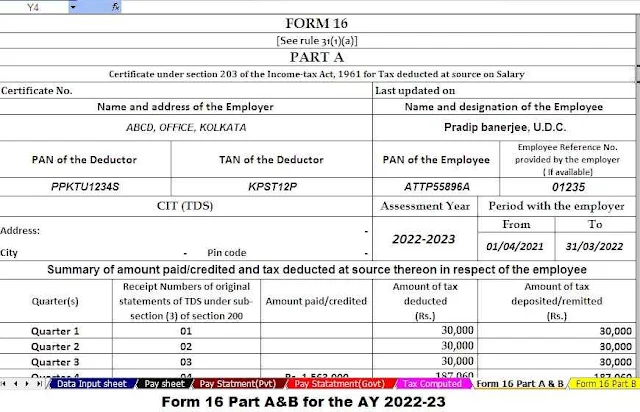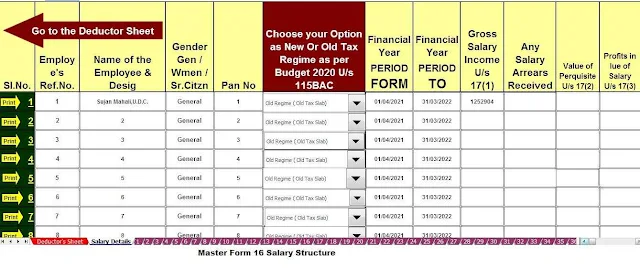Income Tax Section 80CCD | The government imposes mandatory fiscal taxes or fees on the income of
taxpayers, which is the source of government income for financing various government expenditures.
This fee or financial charge is known as a tax. There are two types of taxes. The tax levied on corporate
or individual income is a direct tax, while the tax levied on prices of goods and services is an indirect
tax. Punishable for non-payment or tax evasion. Every citizen has a moral responsibility to pay taxes
on time.
The Government of India has enacted several provisions
under the Income Tax Act 1961 which allow deduction of investments in some
schemes. One such provision is Section 80CCD.
Section 80C is a provision of the Income Tax Act 1961
that allows a maximum deduction of 1.50 lakh for investments made in certain
schemes. Section 80CCD allows you to deduct investments in the NPS (National
Retirement Scheme).
What is 80CCD?
You may
also like:- Autofill Income Tax Form
16 Part A&B for the F.Y.2021-22 [This
Excel Utility can prepare One by One Form 16 Part A&B]
Section 80CCD of the Income Tax Code is a provision
that allows you to deduct contributions made to the NPS. NPS is a notified
pension scheme provided by the Central Government exclusively to the employees
of the Central Government (excluding the Armed Forces) and effective from 1st
January 2004. This scheme was subsequently made available to all citizens of
A contribution made to the N.P.S. by the employee and
employer qualifies for a deduction under Section 80CCD of the Income Tax Act.
The maximum deduction allowed under section is 1.50 lakh including the
deductions allowed under section 80C.
What is NPS?
The National Pension Scheme (NPS), is a new pension
scheme introduced by the Central Government to all citizens of
This system has become a boon in disguise for workers
in the private sector, as they are not entitled to any pension after
retirement. Any Indian national between the ages of 18 and 60 is eligible to
invest in a pension scheme.
There are two types of NPS accounts: a Tier I account
and a Tier II account.
Level 1 Account: Since this account is designed to
create a pool that can be used after retirement, the full amount cannot be
withdrawn at the end of the term. Only 60% of the amount can be withdrawn, and
40% must be invested in an annuity plan without fail in order to receive a
monthly pension.
You may
also like:- Autofill Income Tax Form16 Part B for the F.Y.2021-22 [This Excel Utility can
prepare One by One Form 16 Part B]
Tier II Account: A Tier II account can only be opened
if you have a Tier I account with voluntary Tier-II investments. These
investments are provided to meet short and medium-term needs. There are no
limits for withdrawals from this account.
NPS Highlights
The central government introduced the National Pension
System (NPS) with the aim of facilitating the establishment of a lifelong body
after retirement. The features of this scheme are:
• All Indian nationals between the ages of 18 and 60
are eligible to invest in this scheme.
• An employee in the central government is required to
invest in this system
• For others who are not central government employees,
investment in this system is voluntary.
• The minimum deposit must be 500 each month
• Investment in this system must continue until the
person reaches the age of sixty.
• You have the option to choose from different types
of investments such as fixed income instruments, equity funds and government
securities, but equity fund investments are limited to 50%.
• The investments are linked to the market and the
cost of managing the fund is nominal.
• Upon reaching the age of 60, it is allowed to seize
up to 60% of the hull. 40% of housing must be transferred to a pension plan
without fail.
• There is also a deferment option, but 80% of housing
must be converted to an annuity plan.
• 25% of the total amount is allowed to be used to
fund certain expenses such as medical expenses for you and your family,
education or child marriage expenses, home purchase, etc.
• The Central Government Pension Scheme and the State
Government Pension Scheme are the two main schemes for NIPs. However, since
2009, employees of other organizations can also make voluntary contributions to
the pension system.
You may
also like:- Autofill Income Tax Form
16 Part A&B for the F.Y.2021-22 [This
Excel Utility can prepare at a time 50 Form 16 Part A&B]
Categories within 80CCD: 80CCD(1), 80CCD(1B), 80CCD(2)
Prior to the 2015 Union Budget, the maximum discount
allowed for investment in NPS was Rs 1 lakh. In an effort to encourage citizens
to invest in the pension system, the 2015 budget raised the contribution rate
to 1.50 lakh. In addition, subsection 80CCD (1B) was added to allow an
additional deduction of 50,000 for investments made by each individual taxpayer
in the pension system.
This deduction is in addition to the 1.50 lakh
deduction allowed under Section 80C of the Income Tax Act 1961.
There are other subsections of Section 80CCD that
allow taxpayers to invest in NPS. Details of a contribution that is a
contribution from an employer or business owner must be included in the IT
reports. The transaction report must be submitted as evidence in order to
obtain a tax credit.
You may
also like:- Autofill Income Tax Form16 Part B for the F.Y.2021-22 [This Excel Utility can
prepare At a time 50 Employees Form 16 Part B]
Section 80CCD (1)
Salaried individuals (a government employee or
employee of a non-governmental department organization) and non-paid
individuals who invest in NPS are eligible for a tax deduction under Section
80CCD (1). Details of benefits available under Section 80CCD (1) are provided
below:
• The maximum tax deduction under this section is Rs
1.50 lakh, including deductions permitted under section 80C.
• The maximum deduction that employees may claim under
this section is 10% of their annual salary (base + DA).
• Non-working, ie self-employed workers may qualify
for a 10% deduction from gross income for a given year. However, this limit has
been raised to 20% from the 2017-2018 fiscal year.
An employer may contribute to the NPS in addition to
contributions to the EPF and PPF. This deposit can be made in three ways:
• The employer's contribution can be equal to the
employee's contribution
• The employer's contribution may be higher or lower
than the employee's.
• The employer can make a contribution to the fund on
behalf of the employee
Both the employee and the employer are entitled to
benefits under Section 80CCD (2).
The business owner may record this contribution as a
business expense on the income statement and claim a tax deduction. For these
employer contributions to the NPS, the employee may qualify for a tax credit
under Section 80CCD (2) of the Income Tax Act 1961.
Section 80CCD (1B) of the Income Tax Act 1961 was
introduced primarily to encourage investment under the National Pension Scheme.
Under this section, an additional Rs.50,000 tax credit is available for
investments made by both employees and non-employees. The tax incentives available
under the scheme are listed below:
• This section was introduced as part of the
amendments to the Federation budget for the year 2015.
• Additional Tax Credit of Rs 50,000 for investments
in the pension plans is available in this section.
• Both self-employed and employed persons are eligible
for a tax credit under this section.
• The additional discount allowed is in addition to
the discount allowed under Section 80CCD (1).
You may also like:- Autofill
Income Tax Form 16 Part A&B for the F.Y.2021-22 [This Excel Utility can prepare At a time 100 Employees Form
16 Part A&B
This benefits taxpayers who fall under a higher tax
slab. There is a tax savings advantage of Rs 15,000 for taxpayers under the 30
per cent slab and Rs 10,000 for those under the 20 per cent slab on an
investment of Rs 50,000 in NPS.
Suppose an individual has invested up to Rs 1,50,000
in other specified schemes included in Section 80c other than a contribution of
Rs 50,000 to NPS, then an additional deduction of Rs 50,000 may be claimed
under Section 80CCD (1B), which in addition to a deduction of 1.50 lakh claimed
under section 80C.
Eligibility for an 80CCD tax credit
Eligibility for tax deductions under 80CCD as set out
below:
• An employee may qualify for a deduction under 80CCD
up to 10% of wages (Basic + DA) and a self-employed person may qualify for a
deduction of up to 10% of gross annual income. The maximum claim amount for
80CCD(1) and 80CCD(2) is 1.50 lakh.
• Under section 80CCD of the Income Tax Act, a 1961
contribution made by an employee as well as a self-employed person to the NPS
qualifies for a tax deduction. The employer's contribution to the NPS on behalf
of the employee is also deductible under oath.
• Section 80CCD (1B) allows an additional deduction of
up to $50,000 for any taxpayer's own contribution to the NPS. That being said,
the total deduction allowed under section 80CCD is up to 2 lakhs.
• You can claim these deductions when you file your
income tax return
• Hindu Undivided Families (HUF) are not eligible for
the deduction under Section 80CCD.
• Residents and non-residents of
• If tax deductions are claimed under 80CCD, the same
cannot be claimed under 80C.
Download and prepare at a time 100 Employees Form 16 Part B for the Financial Year 2021-22







